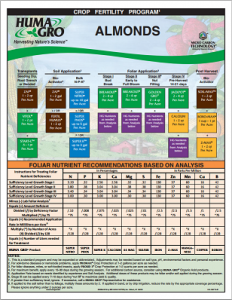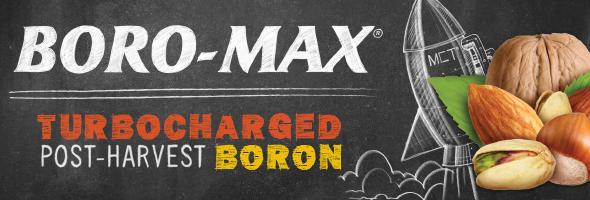Research studies and nut-crop experts consistently agree that boron applied post-harvest can significantly improve harvest the next year. Below, we have links to a sample of articles that provide some details and underscore the importance of post-harvest boron.
![]() Can’t I accomplish the same thing by applying boron during the growing season?
Can’t I accomplish the same thing by applying boron during the growing season?
No. During the growing season, large quantities of boron go into the developing hulls. If foliar boron is applied at that time, most of the boron will go into the hulls and be wasted. Optimal timing of foliar boron application is from well after hull split until the leaves become inactive in the fall. Applications at bud swell work also, but not as well as post-harvest.
![]() Aren’t all boron products the same? Why should I try Huma Gro® BORO-MAX®?
Aren’t all boron products the same? Why should I try Huma Gro® BORO-MAX®?
Huma Gro® BORO-MAX® is complexed with our proprietary Micro Carbon Technology® (MCT). The MCT blend of very small organic molecules allows for more effective absorption of nutrients through the roots, as well as the leaves when foliar applied. This translates into requiring smaller amounts of product to meet plant nutritional needs, allowing growers to make fewer passes, require less storage and mixing capacity, and save application time. All these factors combine to make BORO-MAX® more efficient than standard boron supplements.
![]() Are there additional Huma Gro® products that will help increase my yield?
Are there additional Huma Gro® products that will help increase my yield?
 Yes, Huma Gro® offers a complete range of soil activator, crop nutrition, and crop protection products, including our Z-Max® zinc product. Click the image to the right to see our Almond Crop Program guide that gives a sampling of our product line. More information is available at https://humagro.com/huma-gro-products/.
Yes, Huma Gro® offers a complete range of soil activator, crop nutrition, and crop protection products, including our Z-Max® zinc product. Click the image to the right to see our Almond Crop Program guide that gives a sampling of our product line. More information is available at https://humagro.com/huma-gro-products/.
Boron for Nut Crops, Articles and Links
Rate and Time of Boron Application Increase Almond Productivity and Tissue Boron Concentration. Researchers from the University of California show that, for almonds in California, September boron application was more effective in increasing fruit set and yield than were December or February boron applications.
Post-Harvest Boron Applications Can Increase Almond Yields. Roger Duncan, Pomology Farm Advisor at UC Cooperative Extension, describes why it is important to foliarly apply boron after hull split and before the leaves become inactive so that boron gets into the flower buds that are developing for the next year. He reports research that says post-harvest boron sprays often increased nut set and yield 20%–30% the following year compared with non-treated trees.
Fall Almond Applications of Zinc, Boron, and Potassium. Brent Holtz, County Director and Pomology Advisor, UCCE, has a Western Farm Press article that says boron nutrition often goes unnoticed and should be monitored with hull samples at harvest. If hull samples are less than 80 ppm boron, your trees could be deficient and you may be experiencing a yield loss as a result.
Growing Hazelnuts in the Pacific Northwest. Jeff Olsen, Extension Horticulturist at Oregon State University, has an article in the November 2013 issue of Orchard Nutrition in which he says that boron deficiency is indicated if hazelnut leaf levels are less than 30 ppm. He also recommends foliar zinc sprays when zinc deficiencies are visible in the orchard.
Foliar Application of Zinc and Boron Improves Walnut Vegetative and Reproductive Growth. A research article in HortTechnology reports that the combination of zinc and boron in walnuts resulted in a greater response than either element supplied individually, with increased yields of up to 400% when compared with unsprayed controls.


